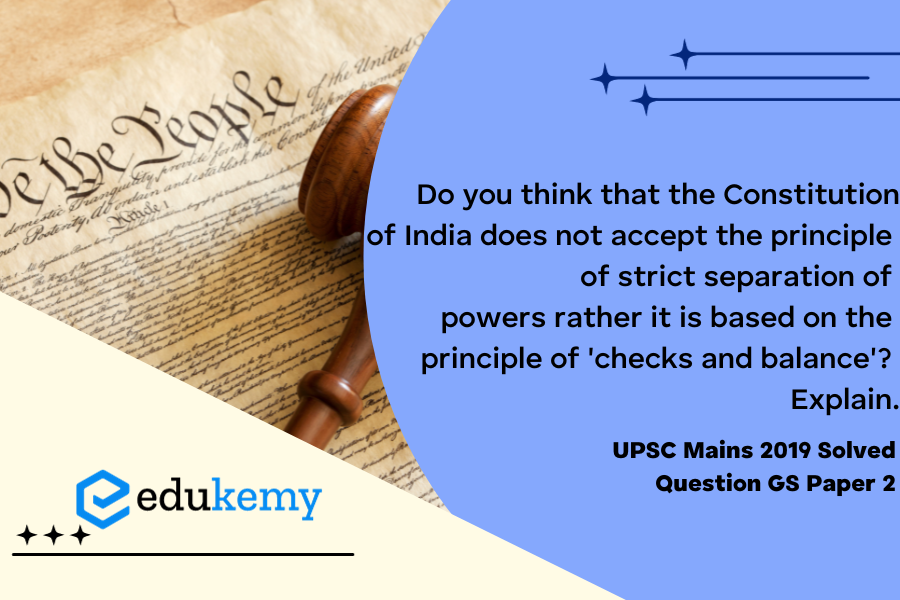The Constitution of India, a formidable document that lays the foundation of the nation’s governance, embodies a distinctive approach to the distribution of powers among its organs. Unlike the rigid doctrine of strict separation of powers, as evident in some Western democracies, India’s constitutional framework is rooted in the nuanced principle of ‘checks and balances.’ The framers of the Indian Constitution, influenced by diverse legal traditions and historical experiences, purposefully designed a system where the executive, legislative, and judicial branches operate with a degree of interdependence and mutual oversight.
Rather than isolating each branch in a silo, the Indian Constitution fosters a dynamic equilibrium through mechanisms that prevent the arbitrary exercise of power. The executive’s authority is subject to parliamentary scrutiny, ensuring accountability. Similarly, the judiciary possesses the power of judicial review, acting as a check on legislative and executive actions. The concurrent and overlapping functions of these branches reflect a conscious effort to prevent tyranny and promote harmonious governance.
In essence, the Constitution of India recognizes the inevitability of collaboration and intersectionality among the three branches while establishing robust checks and balances to safeguard against potential abuse of power. This distinctive approach reflects a pragmatic understanding of governance, acknowledging that the effectiveness of a democratic system lies not in the strict separation of powers but in a delicate equilibrium achieved through thoughtful checks and balances.
Tag: Indian Constitution.
Contents
Decoding the Question:
- In Introduction, try to write briefly about the separation of power.
- In Body,
- Write various Constitutional provisions for the separation of Power in India.
- Discuss how the check and balance system works.
- In Conclusion, try to end your answer with the statement that Indian Constitution exhibits the combination of checks and balances in a positive way.
Answer:
According to the Constitution, there are three organs of government: the Legislature, the Executive, and the Judiciary. Indian constitution has meticulously defined powers and functions of the different organs of the state. Legislature, executive and judiciary have to function within their own spheres demarcated under the constitution. Unlike the US constitution, instead of having a strict separation of power, India follows the principle of ‘checks and balance’ which is evident from the various constitutional provisions dealing with executive, legislative and judicial organs.

Constitutional Provisions for Separation of Power:
- Article 50 (DPSP) of the Constitution separates the Executive from the Judiciary.
- Under Article 123 of the Constitution, the President, being the executive head, is empowered to exercise legislative powers (Promulgate ordinances) in certain conditions.
- Articles 121 and 211 provide that the legislatures cannot discuss the conduct of a judge of the Supreme Court or High Court, except in case of impeachment.
- Under Article 361, the President and Governors enjoy immunity from court proceedings.
System of Checks and Balances in India:
- The executive power of the state is exercised by the President, who acts on the advice tendered by the council of ministers headed by the Prime Minister.
- The power of the Judiciary to exercise judicial review over Legislative and executive actions.
- Under the constitutional provision, Parliament in India includes the Lok Sabha, the Rajya Sabha, and the President. Parliament, the legislative body, has the head of the executive as its integral part. Accordingly, the parliament uses different motions like censure motions, no-confidence motions, etc., to check the functioning of the council and hold them responsible.
- The provision of judicial review and writ under Articles 32 and 226 empowers the Supreme Court and the High Courts respectively to check the constitutional validity of the executive and legislative actions. Independence of the judiciary has been ensured in the constitution but the same has been interlinked with the executive and legislative organs of the government.
- The President, who is the head of the Executive, is an integral part of the Parliament. It can also impeach the President for violation of the Constitution.
The Indian Constitution is the perfect blend of the checks and balances system. It demands to maintain an intricate and delicate balance while exploring the relationship between the three branches. It expects judges, legislators, and executives to be rational, development-oriented, lawful, ethical, and people-centric. Though on the whole, the doctrine of separation of power in the strict sense is not possible in the modern political system, its value lies in emphasis on checks and balances, which are necessary to prevent abuse of power and uphold the rule of law. All three of them are strong pillars of India that support and strengthen each other. Thus, keeps a check and ensures smooth functioning of the whole system and the nation.
In case you still have your doubts, contact us on 9811333901.
For UPSC Prelims Resources, Click here
For Daily Updates and Study Material:
Join our Telegram Channel – Edukemy for IAS
- 1. Learn through Videos – here
- 2. Be Exam Ready by Practicing Daily MCQs – here
- 3. Daily Newsletter – Get all your Current Affairs Covered – here
- 4. Mains Answer Writing Practice – here


